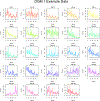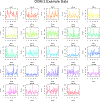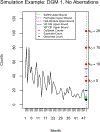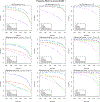Evaluation of Rolling Surveillance Methods in Context of Prior Aberrations: A Simulation Study With Routine Data From Low- and Middle-Income Countries
- PMID: 40277197
- PMCID: PMC12490868
- DOI: 10.1002/sim.70075
Evaluation of Rolling Surveillance Methods in Context of Prior Aberrations: A Simulation Study With Routine Data From Low- and Middle-Income Countries
Abstract
Syndromic surveillance integrated into routine health management information systems could improve timely detection of disease outbreaks, particularly in low- and middle-income countries that have limited diagnostic data. This study evaluates the impact of prior anomalies referred to as "aberrations," such as historical outbreaks, that can distort "baseline data" on the accuracy of rolling surveillance methods that track ongoing disease trends. We assessed five widely used outbreak detection algorithms-EARS, Farrington, Holt-Winters, and two versions of the Weinberger-Fulcher model (negative binomial (WF NB) and quasipoisson (WF QP))-under simulation scenarios motivated by 5 years of acute respiratory infection data from Liberia. We evaluated seven data-generating mechanisms that cover a wide range of temporal and seasonal patterns. We assessed the accuracy of the outbreak detection algorithms under varied size and timing of outbreaks and aberrations. Accuracy was measured through sensitivity and specificity, with a joint assessment of both metrics using pseudo-ROC curves. Results showed that the introduction of aberrations reduced sensitivity in general, but the algorithms' relative performances were highly context-dependent. EARS and WF models demonstrated high sensitivity for detecting outbreaks when no recent aberrations were present. However, when aberrations occurred within the last year of baseline data, Holt-Winters-unless there was evidence of strong time trends-and WF QP maintained better overall balance between sensitivity and specificity. The Farrington algorithm exhibited strong sensitivity with recent aberrations but at the cost of lower specificity. These findings provide actionable insights and practical recommendations for implementing rolling surveillance in resource-constrained environments, emphasizing the need to consider historical data disturbances and rigorously evaluate sensitivity and specificity jointly.
Keywords: aberrations; health management information systems; low‐ and middle‐income countries; outbreak detection; rolling surveillance; sensitivity and specificity.
© 2025 John Wiley & Sons Ltd.
Conflict of interest statement
Conflicts of Interest
The authors declare no conflicts of interest.
Figures












References
-
- Buehler JW, Hopkins RS, Overhage JM, Sosin DM, Tong V, and CDC Working Group, “Framework for Evaluating Public Health Surveillance Systems for Early Detection of Outbreaks: Recommendations From the CDC Working Group,” MMWR - Recommendations and Reports 53, no. RR-5 (2004): 1–11. - PubMed
-
- Wagner MM, Tsui FC, Espino JU, et al. , “The Emerging Science of Very Early Detection of Disease Outbreaks,” Journal of Public Health Management and Practice 7, no. 6 (2001): 51–59. - PubMed
-
- Fienberg SE and Shmueli G, “Statistical Issues and Challenges Associated With Rapid Detection of Bio-Terrorist Attacks,” Statistics in Medicine 24, no. 4 (2005): 513–529. - PubMed
-
- Buckeridge DL, “Outbreak Detection Through Automated Surveillance: A Review of the Determinants of Detection,” Journal of Biomedical Informatics 40, no. 4 (2007): 370–379. - PubMed
